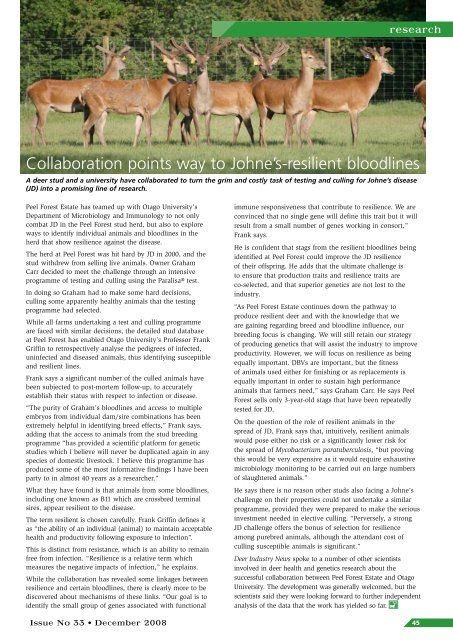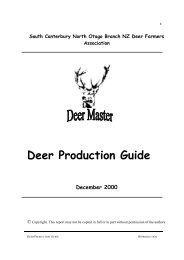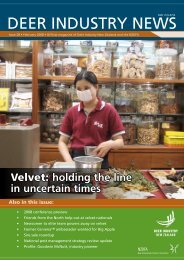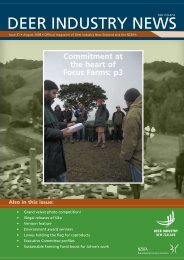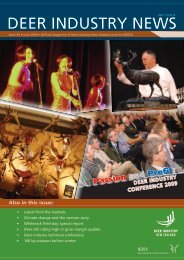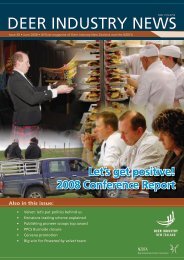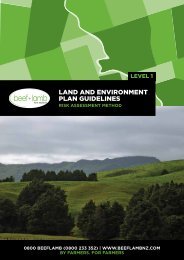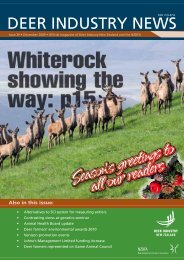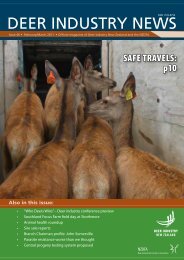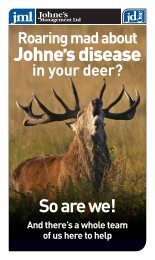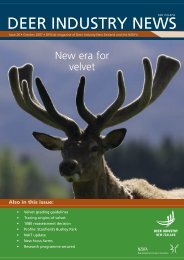Deer Industry News - Deer Industry New Zealand
Deer Industry News - Deer Industry New Zealand
Deer Industry News - Deer Industry New Zealand
Create successful ePaper yourself
Turn your PDF publications into a flip-book with our unique Google optimized e-Paper software.
esearch<br />
Collaboration points way to Johne’s-resilient bloodlines<br />
A deer stud and a university have collaborated to turn the grim and costly task of testing and culling for Johne’s disease<br />
(JD) into a promising line of research.<br />
Peel Forest Estate has teamed up with Otago University’s<br />
Department of Microbiology and Immunology to not only<br />
combat JD in the Peel Forest stud herd, but also to explore<br />
ways to identify individual animals and bloodlines in the<br />
herd that show resilience against the disease.<br />
The herd at Peel Forest was hit hard by JD in 2000, and the<br />
stud withdrew from selling live animals. Owner Graham<br />
Carr decided to meet the challenge through an intensive<br />
programme of testing and culling using the Paralisa® test.<br />
In doing so Graham had to make some hard decisions,<br />
culling some apparently healthy animals that the testing<br />
programme had selected.<br />
While all farms undertaking a test and culling programme<br />
are faced with similar decisions, the detailed stud database<br />
at Peel Forest has enabled Otago University’s Professor Frank<br />
Griffin to retrospectively analyse the pedigrees of infected,<br />
uninfected and diseased animals, thus identifying susceptible<br />
and resilient lines.<br />
Frank says a significant number of the culled animals have<br />
been subjected to post-mortem follow-up, to accurately<br />
establish their status with respect to infection or disease.<br />
“The purity of Graham’s bloodlines and access to multiple<br />
embryos from individual dam/sire combinations has been<br />
extremely helpful in identifying breed effects,” Frank says,<br />
adding that the access to animals from the stud breeding<br />
programme “has provided a scientific platform for genetic<br />
studies which I believe will never be duplicated again in any<br />
species of domestic livestock. I believe this programme has<br />
produced some of the most informative findings I have been<br />
party to in almost 40 years as a researcher.”<br />
What they have found is that animals from some bloodlines,<br />
including one known as B11 which are crossbred terminal<br />
sires, appear resilient to the disease.<br />
The term resilient is chosen carefully. Frank Griffin defines it<br />
as “the ability of an individual (animal) to maintain acceptable<br />
health and productivity following exposure to infection”.<br />
This is distinct from resistance, which is an ability to remain<br />
free from infection. “Resilience is a relative term which<br />
measures the negative impacts of infection,” he explains.<br />
While the collaboration has revealed some linkages between<br />
resilience and certain bloodlines, there is clearly more to be<br />
discovered about mechanisms of these links. “Our goal is to<br />
identify the small group of genes associated with functional<br />
immune responsiveness that contribute to resilience. We are<br />
convinced that no single gene will define this trait but it will<br />
result from a small number of genes working in consort,”<br />
Frank says.<br />
He is confident that stags from the resilient bloodlines being<br />
identified at Peel Forest could improve the JD resilience<br />
of their offspring. He adds that the ultimate challenge is<br />
to ensure that production traits and resilience traits are<br />
co-selected, and that superior genetics are not lost to the<br />
industry.<br />
“As Peel Forest Estate continues down the pathway to<br />
produce resilient deer and with the knowledge that we<br />
are gaining regarding breed and bloodline influence, our<br />
breeding focus is changing. We will still retain our strategy<br />
of producing genetics that will assist the industry to improve<br />
productivity. However, we will focus on resilience as being<br />
equally important. DBVs are important, but the fitness<br />
of animals used either for finishing or as replacements is<br />
equally important in order to sustain high performance<br />
animals that farmers need,” says Graham Carr. He says Peel<br />
Forest sells only 3-year-old stags that have been repeatedly<br />
tested for JD.<br />
On the question of the role of resilient animals in the<br />
spread of JD, Frank says that, intuitively, resilient animals<br />
would pose either no risk or a significantly lower risk for<br />
the spread of Mycobacterium paratuberculosis, “but proving<br />
this would be very expensive as it would require exhaustive<br />
microbiology monitoring to be carried out on large numbers<br />
of slaughtered animals.”<br />
He says there is no reason other studs also facing a Johne’s<br />
challenge on their properties could not undertake a similar<br />
programme, provided they were prepared to make the serious<br />
investment needed in elective culling. “Perversely, a strong<br />
JD challenge offers the bonus of selection for resilience<br />
among purebred animals, although the attendant cost of<br />
culling susceptible animals is significant.”<br />
<strong>Deer</strong> <strong>Industry</strong> <strong><strong>New</strong>s</strong> spoke to a number of other scientists<br />
involved in deer health and genetics research about the<br />
successful collaboration between Peel Forest Estate and Otago<br />
University. The development was generally welcomed, but the<br />
scientists said they were looking forward to further independent<br />
analysis of the data that the work has yielded so far.<br />
Issue No 33 • December 2008 45


